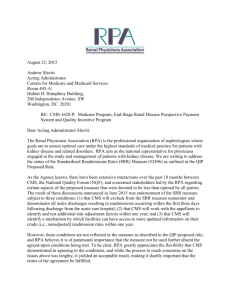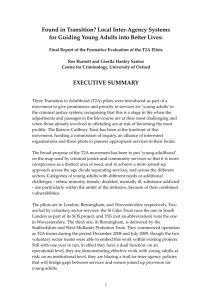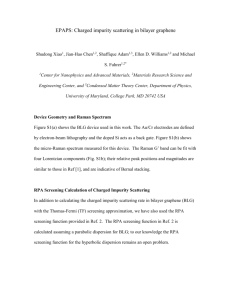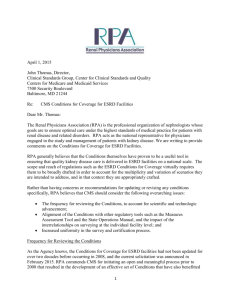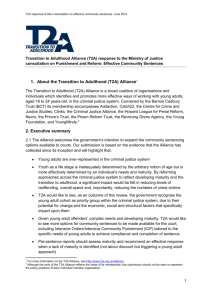T2A response to MoJ Consultation on Transforming Rehabilitation
advertisement
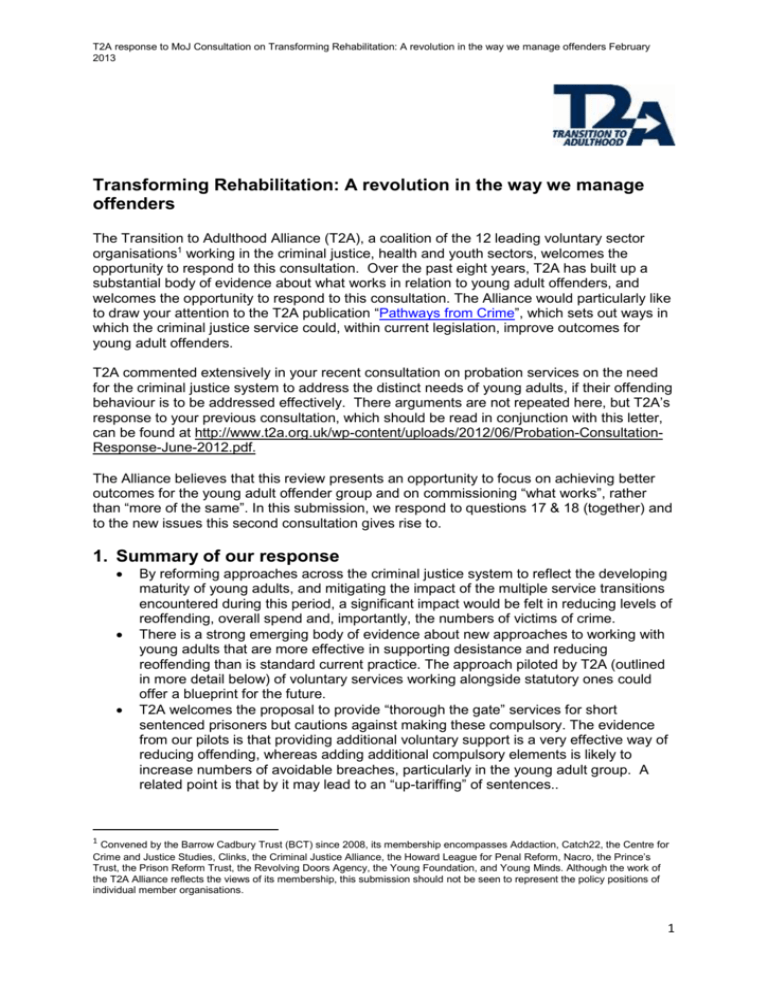
T2A response to MoJ Consultation on Transforming Rehabilitation: A revolution in the way we manage offenders February 2013 Transforming Rehabilitation: A revolution in the way we manage offenders The Transition to Adulthood Alliance (T2A), a coalition of the 12 leading voluntary sector organisations1 working in the criminal justice, health and youth sectors, welcomes the opportunity to respond to this consultation. Over the past eight years, T2A has built up a substantial body of evidence about what works in relation to young adult offenders, and welcomes the opportunity to respond to this consultation. The Alliance would particularly like to draw your attention to the T2A publication “Pathways from Crime”, which sets out ways in which the criminal justice service could, within current legislation, improve outcomes for young adult offenders. T2A commented extensively in your recent consultation on probation services on the need for the criminal justice system to address the distinct needs of young adults, if their offending behaviour is to be addressed effectively. There arguments are not repeated here, but T2A’s response to your previous consultation, which should be read in conjunction with this letter, can be found at http://www.t2a.org.uk/wp-content/uploads/2012/06/Probation-ConsultationResponse-June-2012.pdf. The Alliance believes that this review presents an opportunity to focus on achieving better outcomes for the young adult offender group and on commissioning “what works”, rather than “more of the same”. In this submission, we respond to questions 17 & 18 (together) and to the new issues this second consultation gives rise to. 1. Summary of our response By reforming approaches across the criminal justice system to reflect the developing maturity of young adults, and mitigating the impact of the multiple service transitions encountered during this period, a significant impact would be felt in reducing levels of reoffending, overall spend and, importantly, the numbers of victims of crime. There is a strong emerging body of evidence about new approaches to working with young adults that are more effective in supporting desistance and reducing reoffending than is standard current practice. The approach piloted by T2A (outlined in more detail below) of voluntary services working alongside statutory ones could offer a blueprint for the future. T2A welcomes the proposal to provide “thorough the gate” services for short sentenced prisoners but cautions against making these compulsory. The evidence from our pilots is that providing additional voluntary support is a very effective way of reducing offending, whereas adding additional compulsory elements is likely to increase numbers of avoidable breaches, particularly in the young adult group. A related point is that by it may lead to an “up-tariffing” of sentences.. 1 Convened by the Barrow Cadbury Trust (BCT) since 2008, its membership encompasses Addaction, Catch22, the Centre for Crime and Justice Studies, Clinks, the Criminal Justice Alliance, the Howard League for Penal Reform, Nacro, the Prince’s Trust, the Prison Reform Trust, the Revolving Doors Agency, the Young Foundation, and Young Minds. Although the work of the T2A Alliance reflects the views of its membership, this submission should not be seen to represent the policy positions of individual member organisations. 1 T2A response to MoJ Consultation on Transforming Rehabilitation: A revolution in the way we manage offenders February 2013 MoJ proposes that low and medium risk individuals should be managed differently from high risk offenders. We note that there are difficulties in assigning risk levels to young adults, and that it is very probable that the risk levels of young adults will fluctuate over the course of their sentence. There is an accumulation of evidence, from many sources, that good relationships are key to success with the young adult age group, so arrangements must be put in place to ensure that there is continuity over the course of a supervision order. We argue that it is vital that voluntary and community organisations, many of which have extensive and distinct experience of working with younger offenders, are included in both the design and delivery of services. 2. Why focus on young adults as a distinct group? Young adults (those aged 18-24) are greatly over-represented in the criminal justice system. They are also a group that are the most likely to desist and ‘grow out of crime’. The right intervention can speed up this process; the wrong one can slow desistance and extend the period that a young adult is involved in the criminal justice system. There is a strong emerging body of evidence about new approaches to working with young adults that are more effective than standard current practice. Over the past four years, T2A pilot projects have been testing a distinct approach to working with young adults in three areas (Birmingham, West Mercia and London), putting additional support provided by VCS organisations alongside statutory interventions. The voluntary element consists of services and interventions that support young people to mature, to develop responsibility, temperance and perspective. These run alongside statutory orders and this dual approach has proved highly effective in increasing the likelihood of desistance. A particular feature of the Birmingham pilot, which was run by Staffordshire and West Midlands Probation Service, was a focus on transition between youth and adult services. The recent review of transitions carried out by the Youth Justice Board drew heavily on this approach. The smooth management of transitions between services is essential for effective rehabilitation and management of young offenders. An outcomes evaluation of the pilot projects found that reconviction rates of young adults involved in the projects was 9 per cent. This compares to a national reconviction rate for 1820 year olds of 46 per cent2 (rising to 58 per cent3 for young adults leaving custody). The pilots were cost effective: a break even analysis carried out by Matrix Evidence showed that the services would have to reduce offending by only 28 per cent over two years to break even4. The promising results of the T2A pilots demonstrate that having voluntary organisations and statutory services working in partnership can be a highly effective way of reducing reoffending. There are many organisations in the voluntary sector that understand and have expertise with working with young adults, including those in custody and those that pose a higher risk to the community. It is therefore important that in the new landscape, voluntary sector organisations are included in both the design and delivery of services and that commissioners, and prime contractors, use the emerging evidence base to shape their service planning. 2 MOJ reoffending bulletin 2011 248 Hansard HC, 17 January 2011, c653W 4 http://www.t2a.org.uk/wp-content/uploads/2012/05/T2A-Summative-Evaluation-Catch22-2012.pdf 3 2 T2A response to MoJ Consultation on Transforming Rehabilitation: A revolution in the way we manage offenders February 2013 3. Young adults on short sentences We welcome the government’s decision to increase support on release from prison for those serving short sentences. This is something that T2A has argued for in previous submissions. However the Alliance would caution against making through the gate mentoring compulsory. The essence of mentoring is of a relationship freely entered into by both parties. This is backed up by the experience of the T2A pilots which found that the key advantage they provide in working with this age group is the time and flexibility of T2A workers, the fact that they do not have to enforce sentences and that the participation of the clients is voluntary5. Our experience was that when young people were given the opportunity to engage with rehabilitative services, the majority chose to take up the support offered. Therefore whilst we understand the Ministry of Justice’s aim to ensure every offender receives additional support, we do not believe that sanctions will be needed for non-compliance to achieve the outcomes sought. The additional compulsory requirement being proposed around mentoring we believe has the potential to increase the rate of breach amongst this cohort. As stated in more detail in our previous submission, young adults are amongst the most likely group to breach their sentence given their developing maturity and often multiple needs. We would like to take this opportunity to further highlight the success that the T2A pilots had in reducing breach rates through providing age-appropriate support. If this can be replicated across the country, it has the potential to release substantial cash savings. Lastly, compulsion has the potential to ‘up tariff’ sentences to prison. The Alliance has argued in its report Pathways from Crime that ‘every effort should be made to keep nonviolent young adults (whether on remand or sentenced) out of custody, and enable the courts to issue an intensive community sentence’. We would advocate that this review is used as an opportunity to look again at the sentencing options, including robust community alternatives to prison, that are tailored specifically to young adults. The few existing examples of young adult specific community interventions that exist across the country should be replicated nationally, and similar effective interventions should be available to all sentencers when sentencing a young adult. More should be done to develop the scope of the Attendance Centre requirement, as well as tailoring other available community sentence options to the specific needs of this stage of life. T2A would welcome the opportunity to discuss this in greater detail or to convene meetings with members of the Alliance with particular experience, which might be helpful in informing the design of new sentencing options for young adults. 4. Young adult risk profiles In relation to contracting out work with medium to low risk offenders, we note that assigning risk level to a young adult cohort is challenging. Given their age, many young adults will not have amassed an offending profile that lends itself to being so easily interpreted for this purpose. Additionally, it is likely that risk profile of offenders will be subject to change during the course of their sentence. This is particularly likely to be true of young offenders given their developing maturity. T2A would like to see resources and support put into this age group based on their level of need, not just their level of risk. 5. Personal and professional relationships are key to change 5 http://www.t2a.org.uk/wp-content/uploads/2012/05/T2A-Summative-Evaluation-Catch22-2012.pdf 3 T2A response to MoJ Consultation on Transforming Rehabilitation: A revolution in the way we manage offenders February 2013 A key finding running through research by T2A (and many others) is the prime importance to desistance of the quality of the relationship between an offender and the person providing them with support. The formative evaluation of the T2A pilots summed up the combination of statutory and voluntary services together forming “the provision of a local inter-agency system for guiding young adults into better lives”.6 The researchers identified seven key precepts of the T2A approach which they felt were key to success of working with this age group: Formation of a working alliance based on mutual respect and agreed goals, which increases self-worth of service users and motivates them to remain engaged; Use of strengths-based principals emphasising what a service user can achieve, rather than focussing on weakness or mistakes; An action plan determined by the client, encouraging cooperation because what is required of them is what they want anyway, respecting and promoting the agency of the service user in making changes; The development of a respectful, empathetic relationship so there is a readiness to work together; A client-led model of work, giving the service user a taste for being in control and thereby building up self-efficacy; Connecting service users to material resources and opportunities, promoting changes in self-concept and identity; Through referring and connecting the service users to the material resources and social opportunities they need to “get on” in life, increasing their sense of selfefficacy. This person-centred approach was one of the main differences identified by the evaluators between the traditional approach of the Probation Service and the support provided by theT2A teams. It allowed the T2A pilots to support service users to “feel safe and able to cope” through building up confidence, skills and support networks. It was made clear in the summative evaluation7 of the T2A pilots that, for many of the young people involved in the pilots, the T2A workers provided critical support on what was a complex journey and, without that support, outcomes were likely to have been very different. We strongly urge MoJ to take account when designing services of this need for empathetic, consistent relationships between young adult offenders and those supporting them. The evidence from our work is that providing such support is critical to success with this age group. 6. Payment by results The Alliance welcomes the move away from binary measures of reoffending as a measure of success. We believe that reductions in the frequency and severity of offence are better and more realistic indications of success with this age group (and indeed all offenders). Young adult offenders frequently have complex lifestyles and/or multiple needs, and desistance is a process that takes place over time. It is unrealistic to expect immediate complete cessation of offending. Instead, a positive trajectory would, for many, include a slowing down or reduction in severity in offending on the way to total desistance. Measuring ‘distance travelled’ is a more favourable approach, as is focusing on those factors support desistance such as the achievement of stable accommodation, improving relationships/interpersonal skills, meaningful occupation and reduction in drug and alcohol use. 6 7 Burnett et al, 2010, http://www.t2a.org.uk/wp-content/uploads/2011/09/Oxford-CfC-Final-Evaluation-Report-2011.pdf http://www.t2a.org.uk/wp-content/uploads/2012/05/T2A-Summative-Evaluation-Catch22-2012.pdf 4 T2A response to MoJ Consultation on Transforming Rehabilitation: A revolution in the way we manage offenders February 2013 If you would like to discuss the contents of this submission further, please contact Sarah Thomas, Public Affairs Manager, on 020 7336 4818 or by emailing sarah.thomas@catch22.org.uk From: Debbie Pippard Vice-Chair, Transition to Adulthood Alliance c/o Barrow Cadbury Trust d.pippard@barrowcadbury.org.uk 020 7632 9060 5
